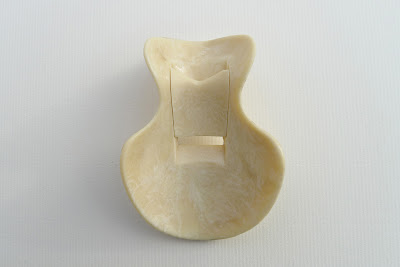My goal is not to forge a Bocarina™, and certainly not to make a market with that (anyway, moulding and casting is much more expensive that buying the original nose flute!). Chris Schuermans had authorized me to experiment with a mould. Indeed, my goal is purely recreational.
[Sequel of the post "Part 1: Hard silicone"]
--
Moulding and Casting - Part 2: casting urethan resin
My first attempt with the new mould was with urethan resin. It's a simple two component resin, the resin itself and its hardener, mixed half/half. The hardening time is very short, more or less 2 minutes, depending on the environment temperature.
So, I weighed 25g of each component (15 would have been sufficient...), mixed them carefully, and poured the mix in my mould. I wasn't sure if my resin was still active, since it had largely exceeded its expiration date.
 |  |

When I unmoulded, I was kind of disappointed: some bubbles had no time to get away from the flute, and particularly at the fipple...


 |  |
 |  |


--
For the scond attempt, I decided to mix less hardener with the resin, but stir the mix more carefully to compensate. Ouch! The result was very funny, but with no bubbles...

The skin is bloated and strange tonalities of brown appeared, making the Boccy look like having been made out of bone. On the sound side: it is correct, but not as powerful as an original, and a bit windy.

 |  |


--
I finally found the solution to my problem: mixing 2 equal parts of the component, but pouring the mix while holding the mould in an oblique position. I should have think of that before, and have slanted the Boccy parts to cast the mould...
So, I tried with a regular mix, but added some pink phosphorescent powder in it. This time, I got no bubbles and a correct quality of skin. The nose flute is not very attractive... unless you wait for the night!!
 |  |

--
The next step was experimenting with colorants. For the first one, I mix some reddish color with the mix-base, then added some blue just in the corner of my mixing box. I forgot to hold the mould in a oblique way, and got a huge bubble (patched with base resin on the picture below):

--
Finally, I managed the color mixing technique. The secret is "not too much, but enough" :). And vary the way of pouring to feed alternatively different colors.
So, I made a series of 4 great boccies. For sure, I gave her each a little name.
The Limerina:



 |  |

with a patch however:

The Strawberry&Cream:

 |  |


The Boar Thigh:


 |  |


Windy Winter:

 |  |

 |  |

--
On the sound side, the best ones (the ones that are perfect for the fipple casting) sounds as good as an original Bocarina™, polypropylene version (the sharper one). The ones with uneven fipple (the ones on which I didn't perfectly glued the insert) sound correct, but a bit "windy.
And now, the family:


To be continued!
-----
On the same topic :
- Moulding and Casting - Part 1: hard silicone
- Moulding and Casting - Part 2: casting urethane
- Moulding and Casting - Part 3: low temp alloys
- Moulding and Casting - Part 4: soft silicone
- Moulding and Casting - Part 5: casting Acrylic
----

Great job!.
ReplyDeleteI think the last four in mixed colors look very nice.
Thank you Luis! Yep, the 4 last ones are the nicest!
ReplyDeleteAll the best
Antoine
Wow, wow, wow, those last 4 ones are perfect in their colour composition, they are AWFULLY nice!
ReplyDeleteTo me, the colour details are totally amazing, as if wonderful works of modern art. This is THE opportunity to create all the colour combinations you could wish for... such fun! The second attempt looks as if it was carved from ivory.
I am very interested in the sound of the "windy" nose flutes. I have always found that the windier the instrument is, the more suitable it is in order to perform "flute music" on it.
Thank you Maikel! I will maybe make so other resin ones, but now I work on other materials...:)
ReplyDeleteGreat work!! Absolutely beautiful! Now I am waiting for candy and cookie bocarinas! And a friend of mine would like a mouse-shaped noseflute (for christmas:)
ReplyDeleteDivas get never satisfied!
ReplyDeleteWOW! just WOW!! these are so beautiful!!!
ReplyDeleteThank you! A difficult process, though...
ReplyDelete